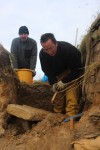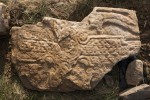The Orkney Islands at the northern tip of Scotland have a uniquely rich archaeological patrimony going back 8,500 years to the Mesolithic era. Because the coastal areas of the archipelago are highly susceptible to erosion, particularly in the winter when storms and tides batter them mercilessly, archaeologists keep a sharp eye out for any artifacts or remains that may have been exposed by erosion.
 That’s what Dr. Hugo Anderson-Whymark was doing on the East Mainland coast when he discovered a stone slab jutting out of the cliff face. He saw that it wasn’t a natural stone, but had been shaped and carved with designs. Much of the carved surface was obscured by its position in the cliff. Dr. Anderson-Whymark was able to see part of the carving, a beast or dragon in an S-shape that is characteristic of Pictish design from the 3rd to the 8th centuries. Because more storms were expected within days, the stone had to be recovered as quickly as possible or risk literally falling off a cliff.
That’s what Dr. Hugo Anderson-Whymark was doing on the East Mainland coast when he discovered a stone slab jutting out of the cliff face. He saw that it wasn’t a natural stone, but had been shaped and carved with designs. Much of the carved surface was obscured by its position in the cliff. Dr. Anderson-Whymark was able to see part of the carving, a beast or dragon in an S-shape that is characteristic of Pictish design from the 3rd to the 8th centuries. Because more storms were expected within days, the stone had to be recovered as quickly as possible or risk literally falling off a cliff.
 The Orkney Research Centre for Archaeology (ORCA), with the aid of Historic Environment Scotland which provided funding for the excavation and conservation of the artifact, sent a team to excavate the slab. Once it was removed, experts identified it as a Pictish cross slab from the 8th century. The stone, 2.8 feet long by 1.8 feet wide and 3.6 inches thick, is incomplete and weathered, but an intricately carved cross stood out on the front face with the dragon/beast at its side. The rear face, even more weathered than the front, featured another beast with what looks like a beak holding a staff.
The Orkney Research Centre for Archaeology (ORCA), with the aid of Historic Environment Scotland which provided funding for the excavation and conservation of the artifact, sent a team to excavate the slab. Once it was removed, experts identified it as a Pictish cross slab from the 8th century. The stone, 2.8 feet long by 1.8 feet wide and 3.6 inches thick, is incomplete and weathered, but an intricately carved cross stood out on the front face with the dragon/beast at its side. The rear face, even more weathered than the front, featured another beast with what looks like a beak holding a staff.
Nick Card, senior projects manager at the University of the Highlands and Islands Archaeology Institute’s Orca, said: “Carved Pictish cross slabs are rare across Scotland with only two having been discovered in Orkney.
“This is therefore a significant find and allows us to examine a piece of art from a period when Orkney society was beginning to embrace Christianity. Now that the piece is recorded and removed from site, we can concentrate on conserving the delicate stone carving and perhaps re-evaluate the site itself.”
Once the stone is cleaned and conserved, ORCA hopes to put it on public display.
Dr. Hugo Anderson-Whymark scanned both sides of the cross slab as soon as it was free and clear, before it was cleaned. Here’s the 3D model created from the scan.
Read about it somewhere else twice, could see the stone on bad images. You déliver both HiRes and 3D, problèm solved. Cheers,
It sounds as if a bit of underwater archaeology off Orkney might be productive.